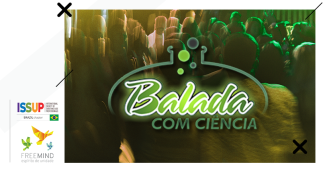Get to know the "Ballad with Science" Project

The emergence of the idea:
There's no denying it: a lot happens at the club! Some cool and some not so much... Some decisions made under the influence of alcohol and other drugs can have lifelong implications. Others, not so much...
International findings show that excessive intake of alcoholic beverages and other drugs in nightclubs and bars is associated with more episodes of physical aggression, risky sexual behavior, sexual violence, and traffic accidents. However, the good news is that all of these risks are minimized when the amount of alcohol and other drugs consumed is reduced.
Thus, in several countries, developing a safe nighttime leisure environment has become synonymous with reducing the excessive consumption of alcohol and other drugs and, indirectly, violence, accidents, and even STD/AIDS contamination. Although drinking is an individual decision, exposing others to risks arising from drinking is a social phenomenon as it can affect other people, not just the drinker.
Several prevention programs aim to reduce the individual and collective risks of the "night out". However, in order to be developed, they need to be grounded in the local reality. For example, the biggest problem for girls who cross the border from San Diego (USA) and Tijuana (Mexico) to go clubbing and drinking before they turn 21 is sexual violence. In this case, "drinking and driving" is no longer the problem, as many cross the border on foot. In several Canadian cities, the issue is the episodes of fights/beatings, often initiated by the staff of the establishment itself. And in Brazil, what are the most present risks in nightclubs? How can we make the night healthier and, consequently, safer for the "partygoers" and for the party?
In this context, the project "Ballad with Science" aims to understand the nightlife scenario in the city of São Paulo, focusing on the consumption of alcohol and other drugs and the associated risk behaviors.
The research method:
Portal survey techniques were used to quantify the consumption of alcohol and other drugs by nightclub goers, at the entrance and exit of the event, as well as episodes of violence and risk behaviors before, during and after the party.
A research team of 8 people in uniform positioned themselves near the entrance line of the club. These interviewers approached about 75 "partygoers" throughout the night. After explaining the ethical procedures of the research and the security of anonymity and confidentiality, the interviewer conducted a 5-10 minute interview and then requested a breathalyzer test. Each interviewee received an event bracelet so that they could be identified at the exit of the club. After the interview, a new breathalyzer test was applied. It is noteworthy that participation was completely voluntary and none of the interviewees were coerced to participate.
The questionnaire addressed information about the interviewee's sociodemographic data (such as age, profession, education, income), the practice of pre-party warm-up (location, type of drink consumed, frequency, expenses, etc.), the conventional pattern of alcohol use (during life and recent) and experimentation with other drugs in life. On the way out, he was asked about the amount of alcohol consumed inside the club and how much was spent, in addition to the breathalyzer. On the day after the party, the interviewee received a link in his email to answer questions about the post-party and then could be submitted to an intervention screen on social norms in alcohol consumption. While the interviewers were outside the club, two researchers were inside the club carrying out environmental measures that allowed the identification of potential risks for alcoholics or that could increase the risks of alcohol poisoning (temperature, number of tables, lighting, sound pressure, among others).
In this study, through the evaluation of environmental and individual factors of the patrons of these establishments, we evaluated the process that triggers the exaggerated consumption of alcohol and its consequences, focusing especially on a way to reconcile the fun of the partygoer, the expectation of financial return of the owner of the establishment and the public health of São Paulo, especially in the context of drinking and driving. unprotected sex and episodes of violence. All the confidentiality and anonymity of the participants was and is guaranteed. No individual data will be disclosed to the media or authorities.
